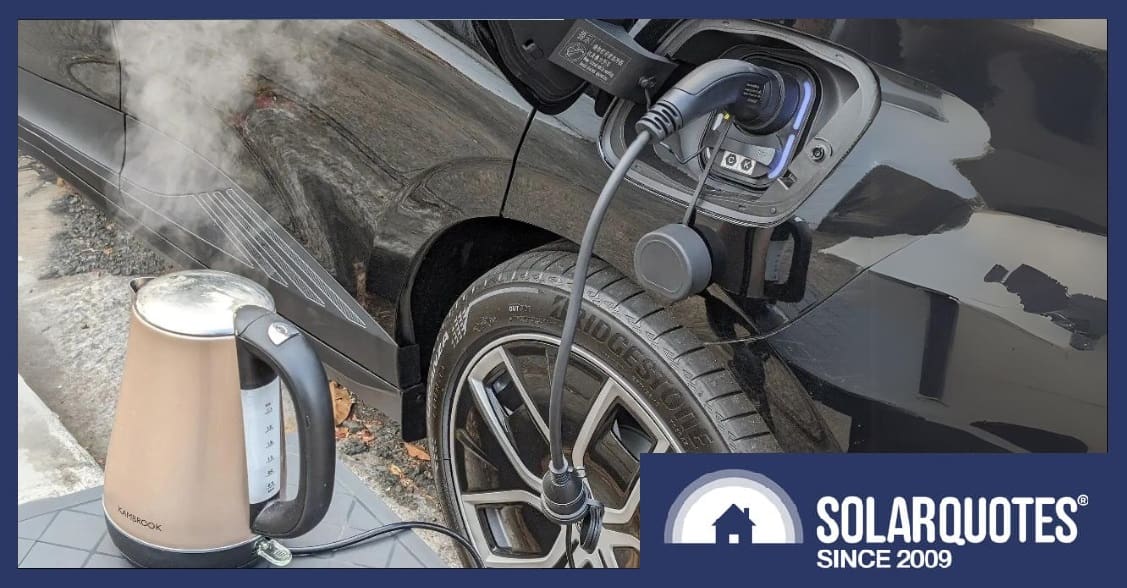
Vehicle To Load technology (V2L) might not get the spotlight like Vehicle to Grid (V2G) or Vehicle To Home (V2H), but it’s already making life easier for many EV owners in Australia. From keeping essentials running during a blackout to powering appliances at a remote campsite, V2L turns your car into a practical, portable source of electricity.
While brands like Hyundai, Kia, MG, and BYD have embraced V2L, Tesla remains noticeably absent from the party. None of Tesla’s models sold in Australia currently support it. Meanwhile, EVs with V2L offer between 2.2 kW and 3.6 kW of power, accessible through either an internal power socket or an external charging port.
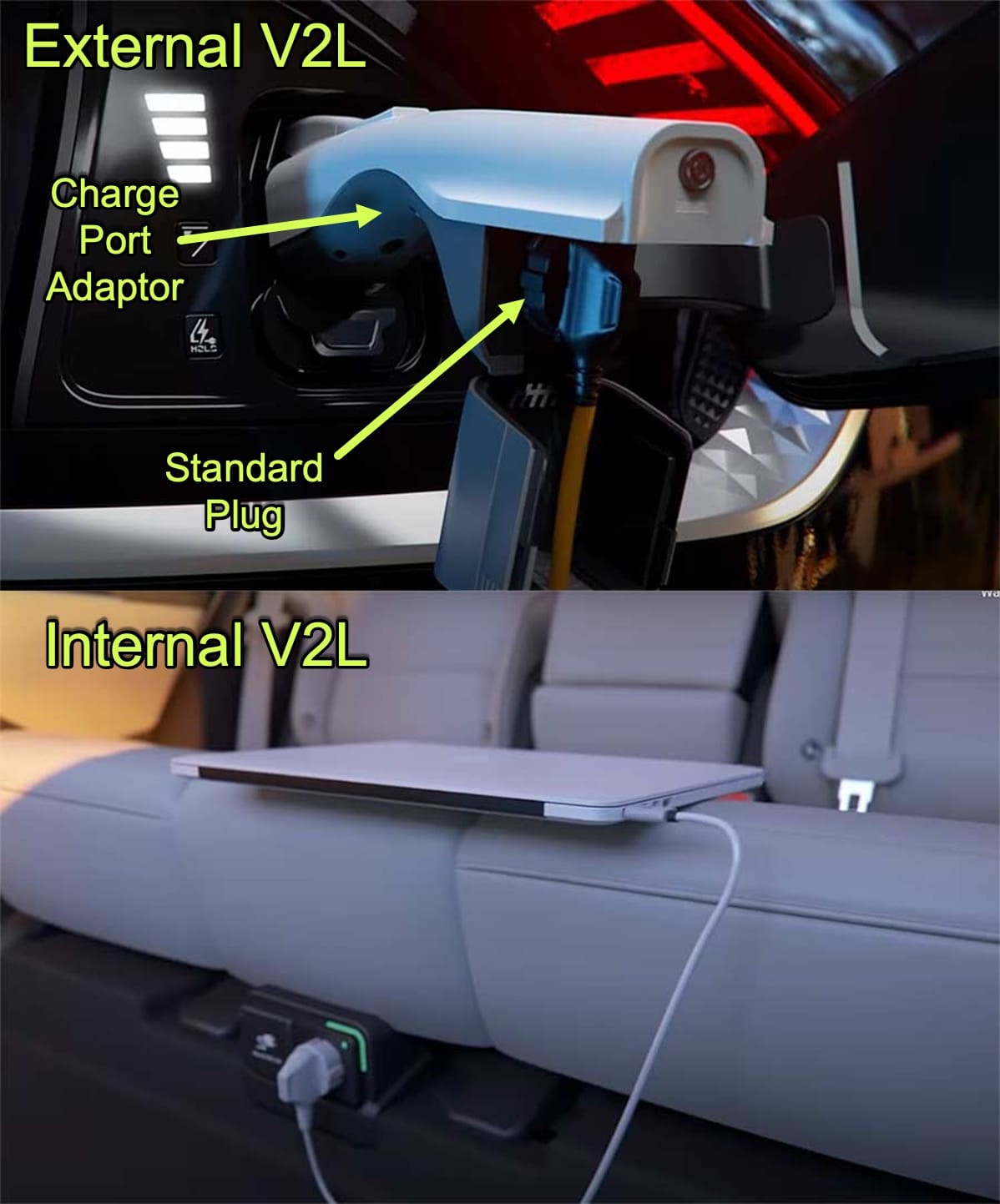
(original images: Kia)
What is V2L?
What’s the best way to describe V2L? I like SolarQuotes in-house installer Anthony Bennett’s description:
“Imagine V2L as a camping generator. It’s legal to use in the same fashion, but quieter and without the lethal fumes.”
If you have a V2L-capable electric car, you can plug things such as an induction cooktop, kettle, or laptop into either an internal single power socket that looks the same as a normal home power socket or externally into the car charge port using a special V2L adaptor.
If your home has a blackout, V2L can power essentials like your fridge and recharge your phones.
| Make & Model | V2L Output | Internal/External V2L |
|---|---|---|
| Hyundai Ioniq 5 | 3.6 kW | Both Internal (240V socket) & External |
| Hyundai Kona EV | 3.6 kW | Internal |
| Kia EV6 | 3.6 kW | Both Internal & External |
| BYD Atto 3 | 2.2 kW | External only |
| MG4 | 2.2 kW | External only |
| Teslas | Not available | N/A |
V2L Adaptors
If you want to use external V2L, a good adaptor is essential to keep things weatherproof, safe and practical. The adaptor converts your car’s charging socket into a standard power point.
An adaptor is sometimes included with a new EV. For example, BYD consistently provides one as standard, while Kia and Hyundai include them with some models. MG, however, does not offer a V2L adaptor as part of their package.
Curious about what makes a high-quality V2L adaptor, I contacted the experts at the custom EV cable company ‘EV Chargers.’ Their insights followed my own experience testing their custom 5m MG4 V2L adaptor at my parents’ garage, where it successfully powered a dryer to dry a load of bath towels.
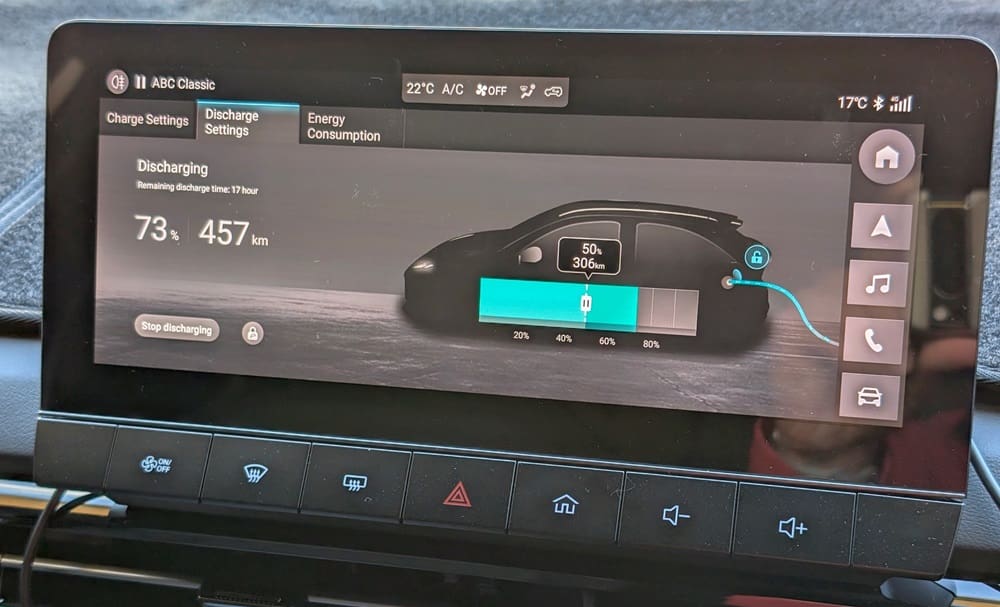
The MG4 in action: This screen shows battery discharge during V2L use.
EV Chargers’ Product Specialist Jason’s advice:
- use an IP67-rated industrial-grade socket with a screw-down ring that can securely lock a matching plug in place.
- longer custom cables with at least 2.5mm wiring are recommended, especially if aiming to run inductive loads like fridges/freezers, which don’t like voltage drop
Real-Life Examples
Using V2L for Emergency Power
Alex lives in Northern NSW and told me he uses his MG4 64 Essence EV to replace his petrol generator (2.8 kW inverter generator), which no longer sees much action.
His setup is:
- 11 kW grid-tied PV system that goes off-line when the grid is down
- A small off-grid PV array (2.2 kW) which supplies basic levels of supplemental energy, in addition to V2L supply when needed
- 15 kWh of off-grid LiFePO₄ solar battery for daily cycling
- Another 20 kWh of sealed lead acid battery, which acts as backup reserve capacity
Alex uses V2L to charge his off-grid home battery, which has proven invaluable during power outages. On one occasion, he discharged 22 kWh from his MG4 over 15 hours to keep essential appliances running during a prolonged grid failure.
Anticipating the outage, Alex had pre-charged his car to 100% using solar PV and free grid energy on his EV plan, instead of the usual 80%. He noted that under normal circumstances, it’s rare not to have 20–30 kWh of spare capacity for such situations.
The MG4’s V2L output was sufficient to power his home essentials and recharge the home battery throughout the outage.
Anthony’s Adage
“If you think you’ll need to back up your house, but don’t fancy rolling out extension cords & desk lamps every time there’s an outage, you’ll want some parts of the switchboard wired to automatically change over when you plug your V2L supply in.1
The HOEM device makes it simple to run your lights & saves having to move the fridge to plug it in.
In fact if you can charge cheaply at work, it’s easy to save a few dollars on electricity every night.”
V2L as a Camping Solution
Hyundai Ioniq 5 EV owner Peter told me on a recent trip from Canberra to East Gippsland they arrived at an off-grid, national park campsite and plugged the trailer into the Ioniq 5’s V2L outlet.
During the three-day campsite stay, Peter’s Hyundai EV V2L powered the fridge, kettle, toaster, microwave, and 2kW induction cooktop.
Peter advised:
“Running the fridge, microwave and induction cooktop on full power simultaneously was not a problem (3.3kW)”.
“After three days, the car’s state of charge was reduced from 89% to 55% of which about 4% was from driving. So, camping activities used about 10% per day. That could be reduced with a more efficient compressor-type fridge”.
“We had the car set to cease V2L discharge if the SOC reached 50% but we could have stayed longer and gone much lower”.
Curious about how V2L fits into your EV lifestyle? Check out our in-depth guide on bi-directional charging on our V2L, V2G, V2H Explained page.
Footnotes
- Some V2L inverters have an RCD or earth leakage safety switch function built in. It’s a bit pointless when the car doesn’t have an earth stake and completely redundant if plugged into your house switchboard. However there can be compatibility problems, with the MEN link in the house causing the safety function to trip. Some cars may need a workaround that we’ll detail in an upcoming post ↩

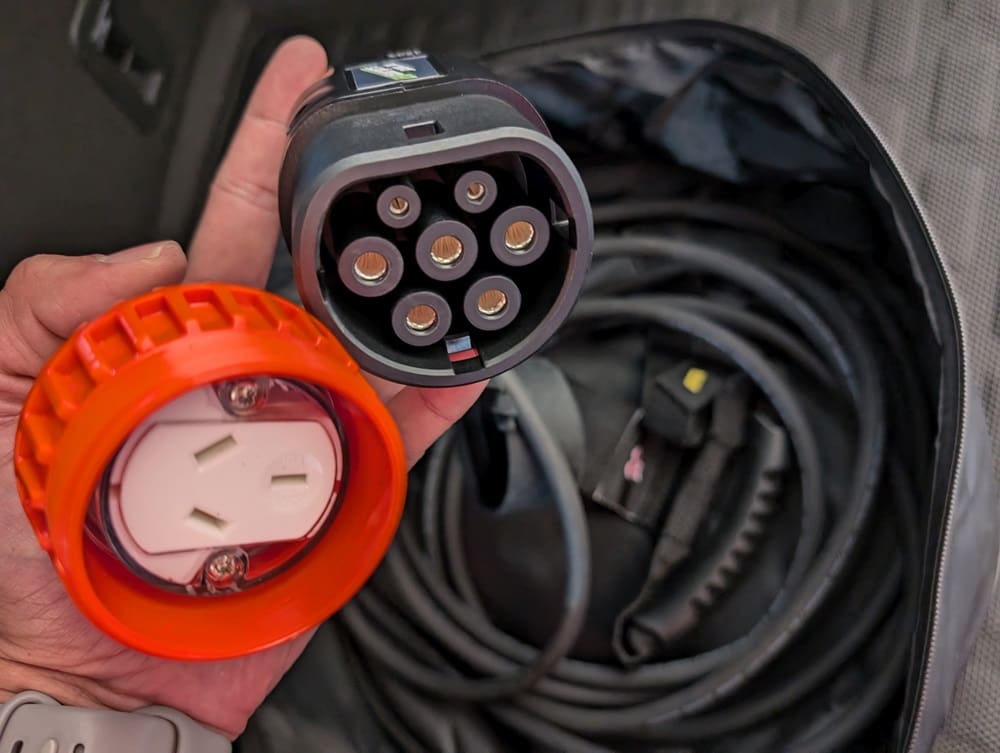
 RSS - Posts
RSS - Posts


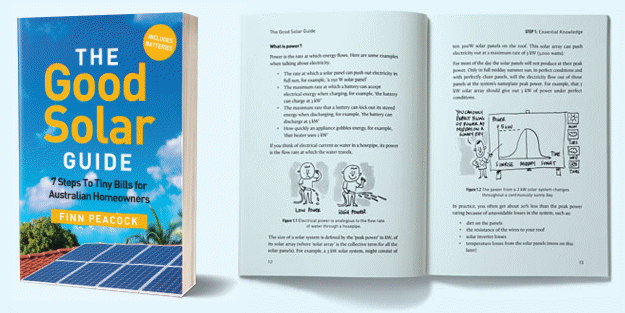
MG4 can output a steady 7 kw with a 32 amp V2L lead with a 470 ohm resistor across the PE to PP terminals.
Don’t try this at home, kids!
Mitsubishi Outander PHEV also has internal outlets, though limited to 1.5kW. When on a powered campsite we charge the car from the mains. When on an unpowered site we use the car to power the AVan for longer than the internal battery.
During a rare blackout in Melbourne, we powered fridge, freezer, standard lamps etc via extension leads. If the car battery got low, the engine would have kicked in. We could have lasted a long time.
Great stuff!
Given I do a bit camping in an EV, I am fairly annoyed my Polestar 2 does not come with V2L, it’s probably the car’s only minor flaw for me.
Just an excuse to upgrade to a Polestar 3 or 4 I guess!
Also, I do already have a home battery that more than meets my daily needs.
I also have a Polestar 2. Did you see this article about successful German trial of bi-directional charging with Polestar 2 in July 2024? https://zecar.com/reviews/polestar-2-bidirectional-charging-v2g-and-v2h-successfully-trialled
Is there any reason why this couldn’t be rolled out with Polestar 2s in Australia ?
I’m considering buying Polestar 2 MY25 or MY26. Do You know of any aftermarket products that would enable vehicle to load functionality in this car through a CCS2 adapter or something of the sort? I love the car but no V2L is a deal breaker. Someone please help me 😭😭
My local MG dealership supplied a V2L cable, in a neat MG-branded zip-up case, on request – at additional cost.
A contributor on another SQ blog has suggested that the MG4 might suffer from the senseless earth leakage sensitivity. I have not yet checked whether it is triggered when feeding into the generator input on a Victron battery inverter, but figure there’ll be no isolation from the MEN there. I’ll read with interest any practical work-around.
But with my off-grid installation powering three families in two households, and charging several EVs, over xmas, without the 46 kWh battery falling below 87% overnight, the need to draw on V2L seems a bit remote.
Living off grid I can’t wait for a V2H car to arrive that will deliver a steady 7kw. 3.6kw just won’t cut it running two households and I do not wish to only run a few circuits with a Hoem set up. I don’t understand why it is taking so long for these to hit the market when having V2H and V2G cars available could take a huge load off the grid.
Our BYD Dolphin came with an external adapter with a 240V powerboard. I have tested it out but not had a need to use it.
We have a heavy duty extension cable ready in case we need to power the fridge at home but, so far, a Powerwall 2 has easily got us through power outages in Sydney.
A pity that older EVs are not capable of V2L. It is tempting to try out the BYD (Type 2 plug) adapter on other models (eg a Volvo PHEV) but that could be a very expensive mistake.
Personally feel V2L is a bit gimmicky.
I mean, it’s a ‘feature’, but who want to go camping and take their vehicle battery down by X mucking about running things you should only be using at home ?
There’s enough charging factors to cope with now for many people with EVs, without using your car battery frivolously when camping.
There are ample small gas cookers to cook / boil water, run some LEDs off any small lithium battery (7 amp hr or so).
A larger 12v 100amp hr AGM will run a fridge and all you need for lighting easily through a night, and not drain below 50% (YMMV).
Sure, there will be the odd time such a feature could work great for you, but as a general power source ?
I think the use cases are going to grow as more people have access to it. Just because it might be gimmicky for you does not mean it will be for everyone.
Anyone who currently packs a small generator or portable power station so they can operate or recharge their equipment on site is a prime example, e.g. recharging batteries for things like laptops, drones or video recording devices. Not having to lug a generator/power station with you is a good thing, saves space and weight.
Others like me have used it several times now for keeping our property operating during extended grid power outages.
It’s simple and easy to use, and the cost of a V2L cable is 1/10th or less than a portable power station plus it has vastly more energy capacity.
You guys could come with a better problem for your solution 😉
“powering appliances at a remote campsite” is the last thing I would do unless there is a cell reception to call a diesel generator to charge your EV.
Having said so, remote sites are for 4WDs which carry canisters with fuel.
Boiling water can also be done with a primitive fire, why waste your charge when you can practice the skill?
!00%
Right – and why have a BEV, when you can take a V8 diesel camping?
“Boiling water can also be done with a primitive fire, why waste your charge when you can practice the skill?”
Ah, so that is why Australia has been burning – kids with matches, trying to boil water.
Why be safe and breathe clean air, when you can start a fire?
…
Hi Nick,
A lot of campers prefer induction cooking these days as they are sick of the gas stove being blown out by winds on the beach, so they have camper trailers with no gas whatsoever.
And many national parks rightly enforce fire bans so you can’t boil a billy, even if you did take the firewood with you. (again collecting firewood in a national park is illegal)
The best part is that you can take solar panels with you, so there’s no need to drill, refine or ship fuel when it’s delivered everywhere, for free, every single day.
I suspect the solution is coming up with better things to complain about 😉
Possibly I have a misconception about what ‘camping’ is about in Australia. Perhaps there is no ‘back to Nature’ as the Nature is not going to provide sustenance anyway. In that case bring the civilization with you.
Regarding the table above, that lists BEV models and their V2L capacities, unfortunately, the V2L capacity is apparently regarded as unimportant by too many manufacturers, and, so, is excluded from the vehicle models’ published specifications, for example (as only one example of many instances), the Chery Omoda E5 range (which has yet to get to Perth, but, is stocked in the eastern states), has V2L, of unspecified capacity (it is a bit like saying “Our car has a motor, but, we are not going to tell you how powerful”).
One vehicle of note, in terms of V2L capacity, that was supposed to be going to be sold in Australia, but, became extinct before it got to Australia, is the Geely Radar RD6 ute, rebranded as Riddara RD6, so it could be sold in Australia (due to trademark of Radar tyres in Australia), which had 16kW V2L capacity, with (from memory) four power points – 2x15A and 2x10A – it would have been a brilliant vehicle, for many applications – tradies, camping, household blackout backup power, etc, but, the manufacturer apparently extinctified it before it got to Australia. And, it was manufactured in RHD, so it could be sold in Australia…
FYI, I test-drove the Chery Omoda E5 in Perth last weekend, they have at least one in stock in Wangara.
Okay.
At
https://www.carsales.com.au/cars/?q=(And.(C.State.Western%20Australia._.Region.Perth.)_.FuelType.Electric._.Odometer.range(..2000)._.(C.Make.Chery._.(C.Model.OMODA%20E5._.Badge.BX.)))&sort=~Price
the only ones listed, are “New car to order” – indicating none in stock for purchase, in the Perth region.
When you took it for a test drive,
1) what did you think of it, and,
2) what was the driveaway purchase price, and,
3) did they have any in stock for purchase (sign the papers, pay the money (or, achieve financing), and collect the car to drive away the next day)?
Briefly:
1) It drove just fine. Interior was okay, felt a bit cheap though. Rear headroom and legroom was a bit disappointing for a large car (I’m 190cm and was a bit cramped in the back, the GWM Ora had more room), but plenty of boot space.
2) Salesrep said he’d have to check but said it was in the $48k ballpark, which is a good $10k more than the recently announced price: https://www.whichcar.com.au/news/2025-chery-omoda-e5-ev-pricing-37k-starting-point
3) I’m not sure as I didn’t ask, but they had a white BX in demo stock. Rep said green was the standard colour, white was extra.
Bret,
As outlined on the other blog, the discontinued Radar RD6 is being replaced by the Radar King Kong, a lower cost update, intended to be more competitive. A poorly (AI) voiced list of specifications of some of the many option variants occurs @4:00 here:
https://www.youtube.com/watch?v=8MEiH2ZX0j4
You may find easier to follow clips, I’m sure.
It seems unlikely that our RHD market will be their first priority, but as you have intimated, they may be surprised by local sales once it does appear. In my view, delayed arrival is merely likely to deliver greater range for the money, as battery prices have fallen substantially in the interim.
The V2L capacity of the RD6 ute, was 6kW for the first edition model; https://www.carsales.com.au/editorial/details/2024-riddara-rd6-electric-ute-primed-for-oz-146672/ and, for the second edition (2025 model), 21kW; https://www.carexpert.com.au/car-reviews/2025-riddara-rd6-review .
So, I was wrong about the stated 16kW V2L capacity, but, the 6kW V2L capacity is higher than (most) other BEV’s, and, probably enough for a single phase household, and, the 21kW V2L capacity, is more than the supply for a household single phase electricity grid connection (on the SWIS grid).
21kW/240V = 87.5A
I wonder whether the HOEM people could come up with a 63A (same as household single phase electricity grid connection fuse, here on the SWIS) adaptor, to cope with that (reduced from the 87.5A, to 63A), if and when the ute with the 21kW V2L capacity, ever comes to Australia…
Pretty sure they “extinctified” (love that description) the original RD ute because the announced price just wasn’t competitive. Instead of being cheap and Chinese it was something like a starting price of $AU90K for an unspectacular range and smallish battery.
The one thing we do wrong with SOLAR PV is that we transmit it too much
I see the EV as a local system provided it is charged from SOLAR PV Panels at the site
the percentaage Power Delivered from transmitted SOLAR is about 35% whilst SOLAR panels supplying loads at DC without inverters can be 95% efficient
Alan Swales
Spot on, Alan.
And when power pylons are storm-flattened, as has happened three times in the last few years, then domestic or micro-grid charging is much more climate resilient.
There’s also media reports of intention to stop grid-connected EV charging on hot summer days, when aircon load is high. That’s presumably due to inadequate grid capacity, as solar generation peaks then. When the grid can’t deliver, then it’s a bit more than just efficiency which makes wireless distribution of radiated fusion energy optimal.
It all has to be done wrong before it can be done right, it seems. So I’m off-grid, charging up to 3 EVs (OK, sequentially. 😉 over xmas, within 5m of the panels.
More critical still, is having power for water pumping in the event of a bushfire. That is no time to be reliant on grid power or town water, as LA demonstrates.
OK, in the last big bushfire around here, it was so dark under the mushroom cloud at 2 p.m. that you couldn’t read the watch on your wrist without a torch, but the 46 kWh battery can run pumps for days of ember defence, or charge the EV for evacuation, without having to start the generator. In such a situation, I wouldn’t use V2L.
Where did you get that 35% from Alan? https://www.eia.gov/tools/faqs/faq.php?id=105&t=3 suggests 95% for the whole transmission grid in the US. Lower figures seem to be “generation and transmission”, from energy in the gas or coal to electrical energy delivered. Most of the losses are in generation. Transmission losses from rooftop PV may be a bit higher due to using the grid “backwards”, but I have never seen figures anywhere near 65% losses in transmission.
Thanks,
David
What are your thoughts on the Kickstarter product promising V2L for Tesla’s at a reasonable price?
https://www.kickstarter.com/projects/vortipower/vortipower-vp2-tesla-3-y-s-x-powershare-external-discharge
As I mention above, it could be risky plugging a V2L adapter into a car that was not designed for it.
Tesla might have future-proofed its models by providing compatibility but I would be very cautious about being a pioneering user.
My MG4 51kWh Excite has V2L with a small problem, which larger MGs do not have:
My V2L is limited to 50% SOC, so if I forget to keep the charge up to that V2L will not work.
An aside: I have always known batteries will become cheaper, but this genius paid $40k for this MG4 which two months later dropped to $31k (2023 model??), now $33k.
Dominic – are you sure the discharge SOC limit for MG4’s 51 kWh model is 50%? The discharge slider on the screen doesn’t really “slide” you need to tap it at the lower SOC level.
Dominic,
I have exactly that T-shirt too. But it was the same for solar pioneers; panels are now 1/10 the cost they paid. And in a few years, there’ll be more EV range for less money, with new battery tech. That’s what happens during the steep part of a disruption curve. But our fuel cost savings will eventually soften the blow, so long as you hold onto the vehicle, rather than try to sell it. That would be a shock.
Worse would to buy an ICE car in a few years, just before the petrol stations begin to disappear, as is happening now in China.
There is one technical aspect regarding the quality of V2L that no EV manufacture seem to state and that is the type of waveform of the supplied 240Vac.
Is it a square wave (worst), modified square wave or a pure sine wave (best) output?
Trying to find this information from various EV manufactures FAQs or help lines have been fruitless.
I’m looking to purchasing an ev soon and one having V2L functionality is a deal breaker.
A good reference that I have just found, that gives a fairly comprehensive list of BEV’s and V2L capabilities, is at
https://evdb.nz/v2l .
Whilst it is NZ, I believe that the information applies to the vehicles listed there, that are available in Australia, and so, equally apply here (for the subset of vehicles that are available here).
It is the only reference that I have seen, that states the V2L capacity of the Chery Omoda E5, as just one of the many examples there.
Of particular interest, whilst it is comparatively, somewhat expensive (I believe), the only Light Cargo Van that has V2L, is the Ford eTransit, with 2.3kW V2L capacity. To me, a BEV van that is to be used by tradespeople, should mandatorily have V2L, so that tradespeople can run powertools, and, charge their battery powered tools, from the battery in the van. Similarly, for BEV utes.
That web page is one of the things where NZ leads Australia – I am not aware of an equivalent resource in Australia, that provides as much information as is included in that table.
It could also (hopefully), incentivise the other manufacturers whose vehicles not not yet have V2L, to upgrade their vehicles, to include V2L. For example, in the Light Cargo Vans, in Australia, as in New Zealand, Peugeot and LDV have Light Cargo Vans, that could be used by tradespeople, but, they lack V2L capability, so, would lose sales.
Also, with the vehicles listed, that have V2L capacity of 3 to 3.6kW, maybe, that could incentivise the other manufacturers, to bring their vehicles up to 3.6kW v2L capacity, which would be far more useful, than the manufacturers, instead of providing improved functionality, concentrating on increasing the street racing capabilities of their vehicles, by shortening the time for standing quarter miles and 0-100km times.
It is up to the manufacturers to determine whether they want to increase sales, by making their vehicles more attractive to the wider population, or, to just attract street racers.
BYD Shark 6. I think the V2L capacity was 6kw (albeit limited to 10A per standard 240v plug..of which there are quite a few) and the inbuilt battery is 30kw
The vehicle is a PHEV and as such when the SOC gets low the 1.5L petrol motor kicks in.
It can tow (really!!!) 2.5T and still have a useful load in the vehicle. If it weren’t for the fact that I swore Id never own a bigass ute in AU, not being a Tradie or someone who actually needs one, id jump at it. 80km of real world pure EV driving on the 30kw battery before you need the petrol motor means that it might be a PHEV but for me I could pretty much use as an EV for 99% of the year and the PHEV for the remainder. suggested at 8L per 100km when the Petrol motor is involved. Recharge from Solar when at home….
Andy
In addition to gross trailer mass, ute/SUV owners also need to check towbar capacity and rear axle capacity. Several popular ute/SUV models (not necessarily EVs or PHEVs) need a rear axle upgrade certified by an engineer in order to legally tow some of the larger vans. I know that on the Sunshine Coast at least one engineer has a portable weighing system and can check all parameters to make sure you are legal.
Some State roadside inspectors check these loads, particularly if they know the ute and caravan models that are likely to be overloaded. Not a great outcome if the breach occurs in the middle of nowhere.
I haven’t experienced this myself but, a few years ago, I did have to trade in a perfectly good vehicle for a larger (PHEV) model in order to tow a new caravan.
A tip for PHEV/EV towing – during long descents engage the manual speed limiter (many modern vehicles have one) and let regenerative braking do the work (manual braking does a similar job but is less effective). I gained more than 10km EV range during one long descent.
Here’s a guy talking about real Shark 6 towing performance. He’s an engineer and as such all the numbers, good and bad, get touched upon rather than glossed over. I believe he has a clue! https://www.youtube.com/watch?v=9JUewoRiLc0
He suggests that the 2.5T braked Towing limit BYD claim is actually achievable with some vehicle payload left for things like humans and fuel etc whereas the 3.5T towing in the usual contenders is indeed 3.5T unless you want some real quantity of fuel or humans to be in the main vehicle.
He also suggests correctly imho that it is never smart to tow a weight greater than the mass of the towing vehicle if you are looking for a peaceful retirement and long life….
Anyway…all that said in the context of Solar quotes it was the 6kw of V2L that imho was the exciting bit for here….
Andy
I’ve got a Shark 6. There are 3 x 10A outlets in the rear tub, but the supplied V2L cable for the CCS2 socket only has a 10A powerboard attached. At some point I’m hoping to get a CCS2 to 15A or 32A adaptor to see what power can be supplied from the CCS2 V2L output. (Maybe try and charge my MG ZS EV @ 7kW just as a test) Doesn’t appear to be any specifically made for the shark and I’m not sure if the shark is expecting to see any particular resistance across certain pins to discharge at higher than 10A like some of the MG’s. (Final target is to be be able to charge the Shark from 11am to 2pm for free and midnight to 6am for 8c/kWh) and discharge it during peak times (into a battery or direct to house if the MEN issues can be resolved)
Not mentioned in the table of EVs with V2L above, the 2022+ KIA Niro has same V2L capability as the bigger, more expensive & less practically shaped KIA EV6.
The 2022 Niro GT Line EV I purchased in Oct 2023, (with just under 5000 “demo kms” on it for a 10.9% saving of full retail price) has V2L capability of 3.6kW from both an internal 230V AC 3 pin socket and externally from its AC charge port with the supplied 3 pin adapter.
The cheaper base model 2022+ Niro only had, at the time of my purchase, the internal V2L socket.